Related Research Articles
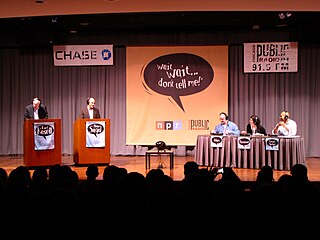
A panel show or panel game is a radio or television game show in which a panel of celebrities participate. Celebrity panelists may compete with each other, such as on The News Quiz; facilitate play by non-celebrity contestants, such as on Match Game and Blankety Blank; or do both, such as on Wait Wait Don't Tell Me. The genre can be traced to 1938, when Information Please debuted on U.S. radio. The earliest known television panel show is Play the Game, a charades show in 1946. The modern trend of comedy panel shows can find early roots with Stop Me If You've Heard This One in 1939 and Can You Top This? in 1940. While panel shows were more popular in the past in the U.S., they are still very common in the United Kingdom.
To Tell the Truth is an American television panel show in which four celebrity panelists are presented with three contestants and must identify which is the "central character" whose unusual occupation or experience has been read aloud by the show's moderator/host. When the panelists question the contestants, the two impostors may lie whereas the "central character" must tell the truth. The setup adds the impostor element to the format of What's My Line? and I've Got a Secret.
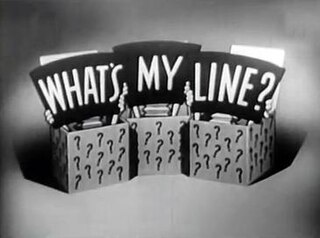
What's My Line? is a panel game show that originally ran in the United States, between 1950 and 1967, on CBS. The game show started in black and white and later in color, with subsequent U.S. revivals. The game uses celebrity panelists to question contestants in order to determine their occupation. The majority of the contestants were from the general public, but there was one weekly celebrity "mystery guest" for which the panelists were blindfolded. It is on the list of longest-running U.S. primetime network television game-shows. Originally moderated by John Charles Daly and most frequently with regular panelists Dorothy Kilgallen, Arlene Francis, and Bennett Cerf, What's My Line? won three Emmy Awards for "Best Quiz or Audience Participation Show" in 1952, 1953, and 1958 and the Golden Globe Awards for Best TV Show in 1962.

I've Got a Secret is an American panel game show produced by Mark Goodson and Bill Todman for CBS television. Created by comedy writers Allan Sherman and Howard Merrill, it was a derivative of Goodson–Todman's own panel show, What's My Line?. Instead of celebrity panelists trying to determine a contestant's occupation, however, as in What's My Line, the panel tried to determine a contestant's secret: something that is unusual, amazing, embarrassing, or humorous about that person.

Figure It Out is an American children's panel game show that aired on Nickelodeon. The original series, hosted by Summer Sanders, ran for four seasons from July 7, 1997, to December 12, 1999. The show was revived in 2012, with Jeff Sutphen as host, with the revival airing from June 11, 2012, to July 16, 2013. The series was originally recorded at Nickelodeon Studios at Universal Studios in Orlando, Florida. The revival episodes were filmed on stage 19 at Paramount Studios in Los Angeles.
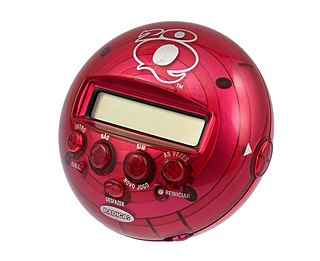
20Q is a computerized game of twenty questions that began as a test in artificial intelligence (AI). It was invented by Robin Burgener in 1988. The game was made handheld by Radica in 2003, but was discontinued in 2011 because Techno Source took the license for 20Q handheld devices.
Botticelli is a guessing game where one person or team thinks of a famous person and reveals the initial letter of their name, and then answers yes–no questions to allow other players to guess the identity. It requires the players to have a good knowledge of biographical details of famous people.
Information Please is an American radio quiz show, created by Dan Golenpaul, which aired on NBC from May 17, 1938, to April 22, 1951. The title was the contemporary phrase used to request from telephone operators what was then called "information" and later called "directory assistance".

The Name's the Same is an American game show produced by Goodson-Todman for the ABC television network from December 5, 1951 to August 31, 1954, followed by a run from October 25, 1954 to October 7, 1955. The premise was for contestants to guess the names of persons whose actual name corresponded to a famous person, celebrity, a place, common object or action.
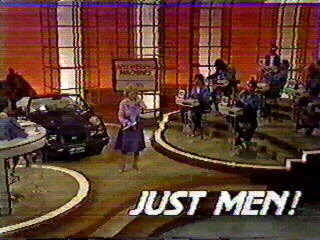
Just Men! is an American game show that aired on NBC Daytime from January 3 to April 1, 1983. The show starred Betty White, who won an Emmy award for her work on the show, with Steve Day announcing. It pitted two female contestants who were asked to predict answers to a series of yes/no questions posed previously to a panel of seven male celebrities.
Does The Team Think? was a radio panel game broadcast originally on the BBC Light Programme from 1957 to 1976, and revived, again on Radio 2, with a new cast, in 2007. It also broadcast as a TV programme.
Love Me, Love Me Not is a Canadian game show based on the Italian game show, M'ama non m'ama, which in English means "love me, love me not". Both shows were created by Steve Carlin, the producer of The $64,000 Question in the 1950s. In 1988 there was a British version of the show, with the same name.
Down You Go is an American television game show originally broadcast on the DuMont Television Network. The Emmy Award-nominated series ran from 1951 to 1956 as a prime time series primarily hosted by Dr. Bergen Evans. The program aired in eleven different timeslots during its five-year run.

It's Anybody's Guess is an American game show broadcast on NBC from June 13 to September 30, 1977. Monty Hall hosted the show while Jay Stewart was the announcer. Produced by Stefan Hatos-Monty Hall Productions, it was Hall's first time hosting a show other than Let's Make a Deal since 1962, when he hosted Video Village.
Personality is an American game show produced by Bob Stewart and hosted by Larry Blyden which ran on NBC from July 3, 1967, to September 26, 1969, at 11:00 AM, EST. The series was produced by Filmways. Bill Wendell, then on the NBC staff, announced the show.
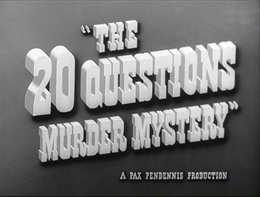
The Twenty Questions Murder Mystery, also known as Murder on the Air, is a 1950 British second feature comedy crime film directed by Paul L. Stein and starring Robert Beatty, Rona Anderson, and Clifford Evans. The film is a hybrid: the Twenty Questions sections take place in a studio recording of the BBC radio programme with the regular panellists and presenter. This is threaded into the plot as the clues trigger a series of murders, each linked to the clue.
@midnight with Chris Hardwick is an American late night Internet-themed panel game show, hosted by Chris Hardwick, that aired Monday through Thursday nights between October 21, 2013, and August 4, 2017, on Comedy Central. It was syndicated internationally in Australia on SBS2 and The Comedy Channel, in the United Kingdom on Comedy Central Extra, and in Canada formerly on MuchMusic and later on The Comedy Network.
Yes, no, black, white is a simple verbal game for two or more players. It can also be considered as a party game and a car game. It has very few and simple rules, requires no equipment, and it's played in multiple countries around the world, primarily in Europe. The game's exact origin is unclear.

Hypothetical is a British television comedy panel show created by British comedian Josh Widdicombe, with Tom Craine and Matthew Crosby. Widdicombe hosts the show alongside fellow comedian James Acaster. The TV series features teams of celebrity guests, who are presented with a bizarre hypothetical situation by Widdicombe. The guests must explain how they would deal with the situation, following the rules given by Acaster, who then awards points based on how well he thinks they have done. The show ran for four series, from 6 February 2019 to 6 July 2022.

Twenty Questions, based on the guessing game Twenty questions, started as a radio quiz show in 1946. The television series ran on NBC in 1949, on ABC from 1950 to 1951 and on the DuMont Television Network from 1951 to 1954.
References
- ↑ Walsorth, Mansfield Tracy. Twenty Questions: A Short Treatise on the Game, Holt, 1882.
- ↑ Peirce, C. S. (1901 MS), "On The Logic of Drawing History from Ancient Documents, Especially from Testimonies", manuscript corresponding to an abstract delivered at the National Academy of Sciences meeting of November 1901. Published in 1958 in Collected Papers v. 7, paragraphs 162–231; see 220. Reprinted (first half) in 1998 in The Essential Peirce v. 2, pp. 75–114; see 107–110.
- ↑ Wheeler, John Archibald; Zurek, Wojciech Hubert (1983). Quantum theory and measurement. Princeton, New Jersey. p. 202. ISBN 978-1-4008-5455-4. OCLC 888216845.
{{cite book}}: CS1 maint: location missing publisher (link) - ↑ Gribbin, John; Gribbin, Mary; Gribbin, Jonathan (2000-02-22). Q is for Quantum: An Encyclopedia of Particle Physics. Simon and Schuster. ISBN 9780684863153.
- ↑ Dunning, John (1998). On the Air: The Encyclopedia of Old-Time Radio. Oxford University Press. pp. 685–686. ISBN 978-0195076783 . Retrieved 30 May 2020.
- ↑ "NRK". Nrk.no. 2009-06-20. Retrieved 2009-07-25.
- 1 2 "Obituary: Norman Hackforth". The Independent . 1996-12-18. Retrieved 2009-08-26.
- ↑ UK Game Shows: "20 Questions"
- ↑ David Kynaston (2008). Austerity Britain 1945–51. Bloomsbury. p. 583. ISBN 978-0-7475-9923-4.
- ↑ "Guess What?". RadioListings. Retrieved 2013-07-23.